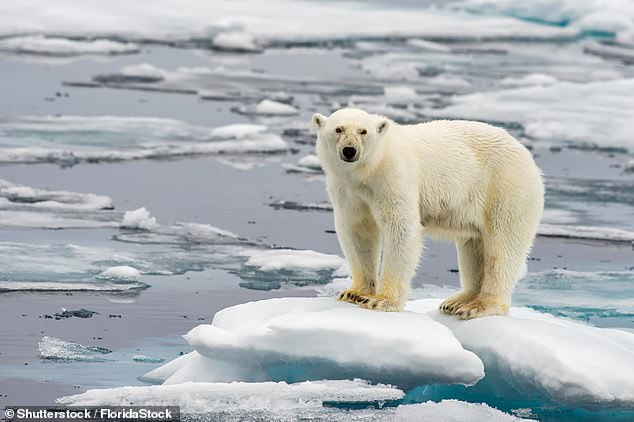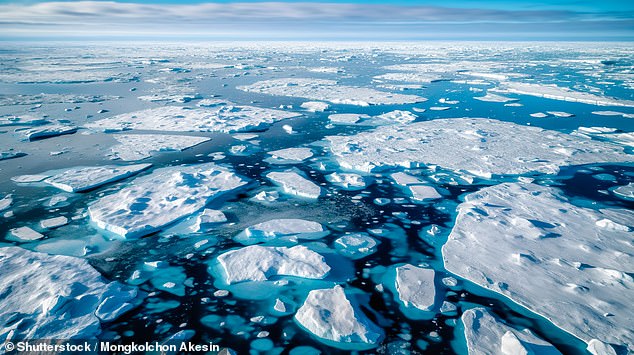With the hottest year in history just behind us, it is perhaps not surprising that the world’s sea ice is in dire condition.
Arctic sea ice has now dipped to its second lowest extent for January, with the edge of the ice field pushed well north of its usual position.
According to the US National Snow and Ice Data Centre (NSIDC), the ice extent was down 498,000 square miles (1.29 million square kilometres) compared to the 1981 to 2010 average.
That means the Arctic is now missing an area of ice six times the size of Wales.
Researchers say this is due to abnormally warm temperatures which have prevented ice from forming properly over the winter.
Conditions have been especially hot in the north of Greenland and over central Alaska where temperatures were up to 8°C (14°F) above the average.
This means that Hudson Bay, a large area of salt water in northeastern Canada, has only just been covered with ice despite normally freezing over in mid-December.
However, the sea ice extent was still 19,000 square miles (50,000 square kilometres) above the record-low for the month set in 2018.

Using data gathered by satellite, NSIDC calculates that Arctic sea ice covered an average of 5.07 million square miles (13.13 million square kilometres) last month.
That is 300,000 square miles lower than the average for January 2024, when Arctic ice covered 5.37 million square miles (13.92 million square kilometres) – the 20th lowest for the month.
While ice grew in Hudson Bay and in the Bering Sea, the ice sheet pulled back further to the north in areas such as the Labrador Sea and the Sea of Okhotsk.
However, satellite data shows that the edge of the ice sheet was further north than the 1981-2010 average in almost all areas.
This follows a record low December when Arctic sea ice levels plummeted below the previous record thanks to delayed growth in Hudson Bay and in the Barents Sea.
Conditions for sea ice have been poor primarily due to exceptionally warm air and water temperatures in the Arctic.
According to the Copernicus Climate Change Service (C3S), 2024 was officially the hottest year on record.
Surface temperatures were their hottest on record for every populated continent, with the exception of Oceania which experienced its third warmest year.


On average, 2024 was 0.72°C (1.3°F) warmer than the 1991-2000 average and a sweltering 1.6°C (2.88°F) hotter than the average for the pre-industrial period between 1850 and 1900.
Likewise, the annual average sea surface temperature over the extra-polar ocean reached a record high of 20.87°C (69.57°F), 0.51°C (0.92°F) above the 1991–2020 average.
According to data gathered by NSIDC, average air temperatures were above average for almost the entire Arctic Ocean which made it harder for ice to form.
In Hudson Bay, these warmer temperatures combined with strong winds from the Northeast, sweeping out previously frozen ice and keeping the bay clear for longer than normal.
This forms part of an ongoing trend in which the Arctic sea ice extent has reduced year on year as the climate warms.
Including January 2025, the Arctic has lost 16,000 square miles (41,000 square kilometres) of sea ice each year, or 2.8 per cent of its total relative to the 1981-2010 average.
Since 1979, that means the Arctic has lost 726,000 square miles (1.88 million square kilometres) of sea ice – an area almost the same size as Alaska.
In another important detail, scientists also found that Arctic sea ice has been getting smoother over the last three decades.


When ice flows push up against each other they form deep pressure ridges known as keels.
The NSIDC writes in a blog post: ‘Normally, ice that has survived several summers is characterized by many pressure ridges.
‘As this older ice melts away, it is replaced by first-year ice which tends to be smoother.’
Starting in 1993, scientists have been flying aircraft over the Arctic Ocean to see how rough the ice is.
Their new study shows that the keels have declined in size and number, suggesting that more ice is melting in the summer.
In the worst affected areas around the North of Greenland, ridge heights have shrunk by up to 10 per cent per decade which shows that much of the older ice is being lost.
That is bad news for the wildlife such as plankton, algae, crustaceans and seals which make their homes among the deep keels.
Meanwhile, in the Antarctic, despite a promising start to the month sea ice extents have also dropped to near record lows.



During the first half of January, a slow pace of ice loss meant that daily ice extents briefly rose above the long-term average.
However, this was followed by rapid ice loss in the Weddell and Ross seas which pushed average extents down.
In the second half of the month the Antarctic saw the 12th lowest ice extent for a day in the 46-year record and finished the month in the lowest 10 per cent of daily values.
While the Antarctic sea ice still covers about 386,000 square miles (one million square kilometres) more than the record low for January set in 2023, above-freezing temperatures are now the rule.

